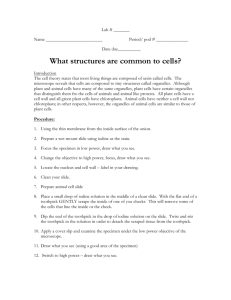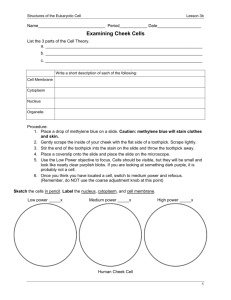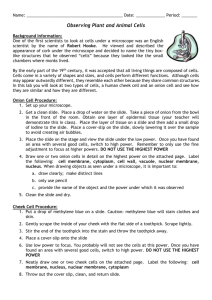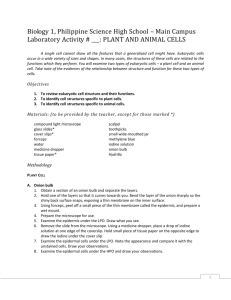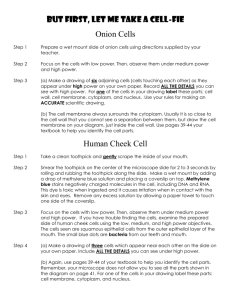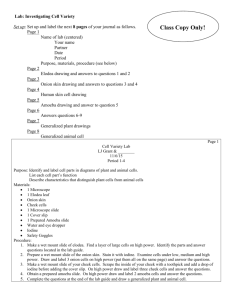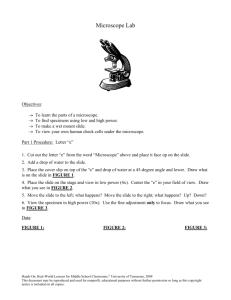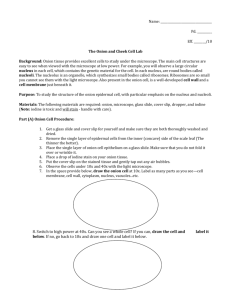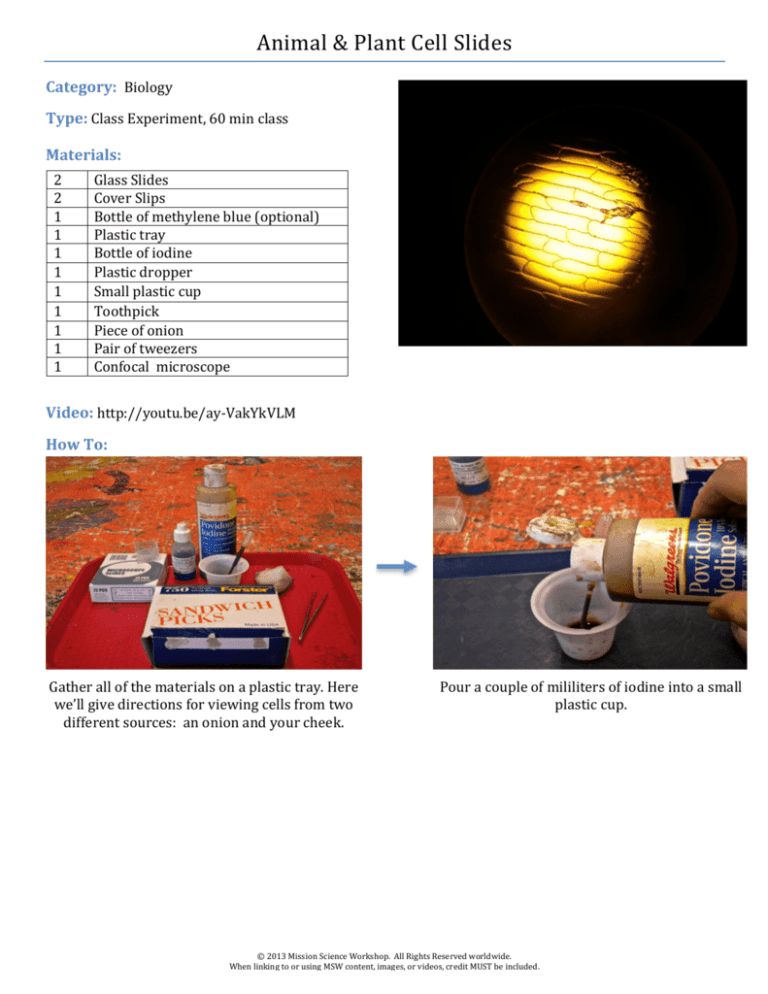
Animal & Plant Cell Slides Category: Biology Type: Class Experiment, 60 min class Materials: 2 2 1 1 1 1 1 1 1 1 1 Glass Slides Cover Slips Bottle of methylene blue (optional) Plastic tray Bottle of iodine Plastic dropper Small plastic cup Toothpick Piece of onion Pair of tweezers Confocal microscope Video: http://youtu.be/ay-­‐VakYkVLM How To: Gather all of the materials on a plastic tray. Here we’ll give directions for viewing cells from two different sources: an onion and your cheek. Pour a couple of mililiters of iodine into a small plastic cup. © 2013 Mission Science Workshop. All Rights Reserved worldwide. When linking to or using MSW content, images, or videos, credit MUST be included. To prepare the onion slide, place a clean glass slide on the tray.. Squeeze one drop of iodine onto the slide using the plastic dropper. Take a slice of onion and peel a small piece of skin off from the inside, as shown above. Use the tweezers or your nails to lift it. The piece of onion should be just big enough to fit onto the glass. Using your fingers and tweezers place the onion skin on top of the iodine. Place another drop of iodine on top of the onion. © 2013 Mission Science Workshop. All Rights Reserved worldwide. When linking to or using MSW content, images, or videos, credit MUST be included. Using the tweezers, slowly drop one cover slip over the onion. This helps to prevent air bubbles, which would make it harder to see the cells clearly. The onion slide is now ready to look at under the microscope. For the cheek cell slide you’ll need one glass slide, one cover slip, methylene blue stain and a toothpick. If you have it, place one drop of the methylene blue onto a clean slide. Using the end of the toothpick, scrape the inside of your cheek to collect cells. Take the end of the toothpick used to scrape the inside of your cheek and rub it on the slide in the methylene blue stain. Thow the away the toothpick © 2013 Mission Science Workshop. All Rights Reserved worldwide. When linking to or using MSW content, images, or videos, credit MUST be included. Like before, gently lower the cover slip over the stain and cheek cell mixture. The cheek cell is also now ready to look at under the microscope Plug in and turn the microscope on. Clip a slide into place and look! Adjust the focus and light as necessary. Start with low magnifications and move up. To take a picture of the magnified slide, hold a camera up to the lens of the microscope. This is the onion slide at x10 magnification. Fine Points: →
→
→
→
→
→
→
→
→
Iodine and methylene blue are stains; be careful not to get any on your clothes! If you have no methylene blue, you can also use iodine for the cheek cells. If needed, disposable gloves can be used. The onion can be cut prior to commencement of a class. Use the tweezers to make sure the onion skin is flat and to push out any air bubbles that might be trapped under the onion skin. When scraping for cheek cells, don’t scrape too hard. You don’t want to draw blood or cut yourself. To focus the specimen, adjust the large coarse focus knob first and then the smaller fine focus knob. These are normally located at the side of the microscope. To change the amount of light, adjust the iris diaphragm, this is located under the platform the slide sits on. You can observe more carefully if you try to draw what you see in the microscope. 10X magnification is possible with small, thick magnifying glasses. You have to put the object very close to the glass, but you get the same view without the microscope. © 2013 Mission Science Workshop. All Rights Reserved worldwide. When linking to or using MSW content, images, or videos, credit MUST be included. Objectives: During this lab, students will learn to: 1. Prepare cell slides for viewing under a microscope. 2. Understand the basics of using a microscope. 3. Identify differences between a plant and animal cell. Concepts Involved: •
•
•
Cells are the building blocks of life. Cells have several parts, i.e. cell membrane, cell wall etc. There are similarities and differences between plant and animal cells. Focus Questions: 1.
2.
3.
4.
5.
What if we didn’t use iodine or methylene blue? (Try it!) How do the stains help when looking at cells? How do onion cells look under the microscope? How do cheek cells look under the microscope? What do you think the differences are between plant and animal cells? Elaboration: All living organisms on Earth are divided into pieces called cells, which are often called the building blocks of life. Organisms are categorized as being either unicellular or multicellular. Unicellular organisms consist of a single cell, and are the simplest cells that exist today. An example is bacteria: each one is a single, self-­‐contained, living cell. Plants and humans are multicellular organisms; humans are made of approximately 10 trillion cells. This number doesn’t include our gut bacteria, which number around 100 trillion! Most plant and animal cells are so small that we can only see them using a microscope. The parts of cells are so transparent that they are difficult to see. Therefore, a number of stains have been developed that help biologists to see the cells and their components by adding color. In this experiment we use two, iodine and methylene blue. Iodine is used as an indicator for starch. When starch and iodine mix they turn a dark blue color and this allows us to see parts of the cells. Methylene blue stains animal cells to make the nuclei more visible. If you don’t have the stains, you can try to view cells without them, or try any strong colored liquid you have to see if it helps in viewing the cells. Plant and animal cells have a number of similarities but also a number of differences. One noticeable difference is that plant cells have a fixed rectangular shape, while animal cells tend to have a round or irregular shape. The reason for this is that plant cells have both a cell wall (made mostly of cellulose) and cell membrane, and animal cells only have a cell membrane. The purpose of the cell wall in plants is to make cells rigid and strong, and also to allow the plants to grow and hold their shape. One other major difference is the presence of chloroplasts in plant cells. Chloroplasts produce food for plants, and they convert the energy of the sun in to the molecular bonds within sugars and starches, a process that is known as photosynthesis. This is also the same process that is responsible for creating the oxygen that we breathe. In plant cells there are also large vacuoles present. Vacuoles are storage bubbles. In animal cells one or two small ones may be present but in plant cells there is normally one that occupies 30-­‐80% of the cells © 2013 Mission Science Workshop. All Rights Reserved worldwide. When linking to or using MSW content, images, or videos, credit MUST be included. volume. (Next time you eat some lettuce, remember that it’s mostly vacuoles!) The vacuoles have a number of functions including; containing water, containing waste products and isolating things that might be harmful to the cell. Plant and animal cells have a number of similarities; including the nucleus, cell membrane, cytoplasm, mitochondria, lysosomes, rough and smooth endoplasmic reticulum and golgi apparatus. Links to k-­‐12 CA Content Standards: Grades k-­‐8 Standard Set Investigation and Experimentation: Scientific progress is made by asking meaningful questions and conducting careful investigations. As a basis for understanding this concept and addressing the content in the other strands, students should develop their own questions and perform investigations. Grades k-­‐12 Mathematical Reasoning: 1.0 Students make decisions about how to approach problems: 1.1 Analyze problems by identifying relationships, distinguishing relevant from irrelevant information, sequencing and prioritizing information, and observing patterns. 1.2 Determine when and how to break a problem into simpler parts. 2.0 Students use strategies, skills, and concepts in finding solutions: 1.1 Use estimation to verify the reasonableness of calculated results. 1.2 2.2 Apply strategies and results from simpler problems to more complex problems. 1.3 Use a variety of methods, such as words, numbers, symbols, charts, graphs, tables, diagrams, and models, to explain mathematical reasoning. 2.5 Indicate the relative advantages of exact and approximate solutions to problems and give answers to a specified degree of accuracy. 3.0 Students move beyond a particular problem by generalizing to other situations: 3.1 Evaluate the reasonableness of the solution in the context of the original situation. 3.2 Note the method of deriving the solution and demonstrate a conceptual understanding of the derivation by solving similar problems. 3.3 Develop generalizations of the results obtained and apply them in other circumstances. Grade 5 Standard Set 1. Cell Biology Plants and animals have structures for respiration, digestion, waste disposal, and transport of materials. As a basis for understanding this concept: 2.a. Students know many multicellular organisms have specialized structures to support the transport of materials.
Grade 7 Standard Set 1. Cell Biology
All living organisms are composed of cells, from just one to many trillions, whose details usually are visible only through a microscope. As a basis for understanding this concept: 1.a. Students know cells function similarly in all living organisms. 1.b. Students know the characteristics that distinguish plant cells from animal cells, including chloroplasts and cell walls. © 2013 Mission Science Workshop. All Rights Reserved worldwide. When linking to or using MSW content, images, or videos, credit MUST be included. Grade 7 Standard Set 2. Structure and Function in Living Systems The anatomy and physiology of plants and animals illustrate the complementary nature of structure and function. As a basis for understanding this concept: 7.a. Students know plants and animals have levels of organization for structure and function, including cells, tissues, organs, organ systems, and the whole organism. Grades 9-­‐12 Standard Set 1. Cell Biology The fundamental life processes of plants and animals depend on a variety of chemical reactions that occur in specialized areas of the organism’s cells. As a basis for understanding this concept: 1.a. Students know cells are enclosed within semipermeable membranes that regulate their interaction with their surroundings. 1.c. Students know how prokaryotic cells, eukaryotic cells (including those from plants and animals), and viruses differ in complexity and general structure. 1.j. Students know how eukaryotic cells are given shape and internal organization by a cytoskeleton or cell wall or both. © 2013 Mission Science Workshop. All Rights Reserved worldwide. When linking to or using MSW content, images, or videos, credit MUST be included.

